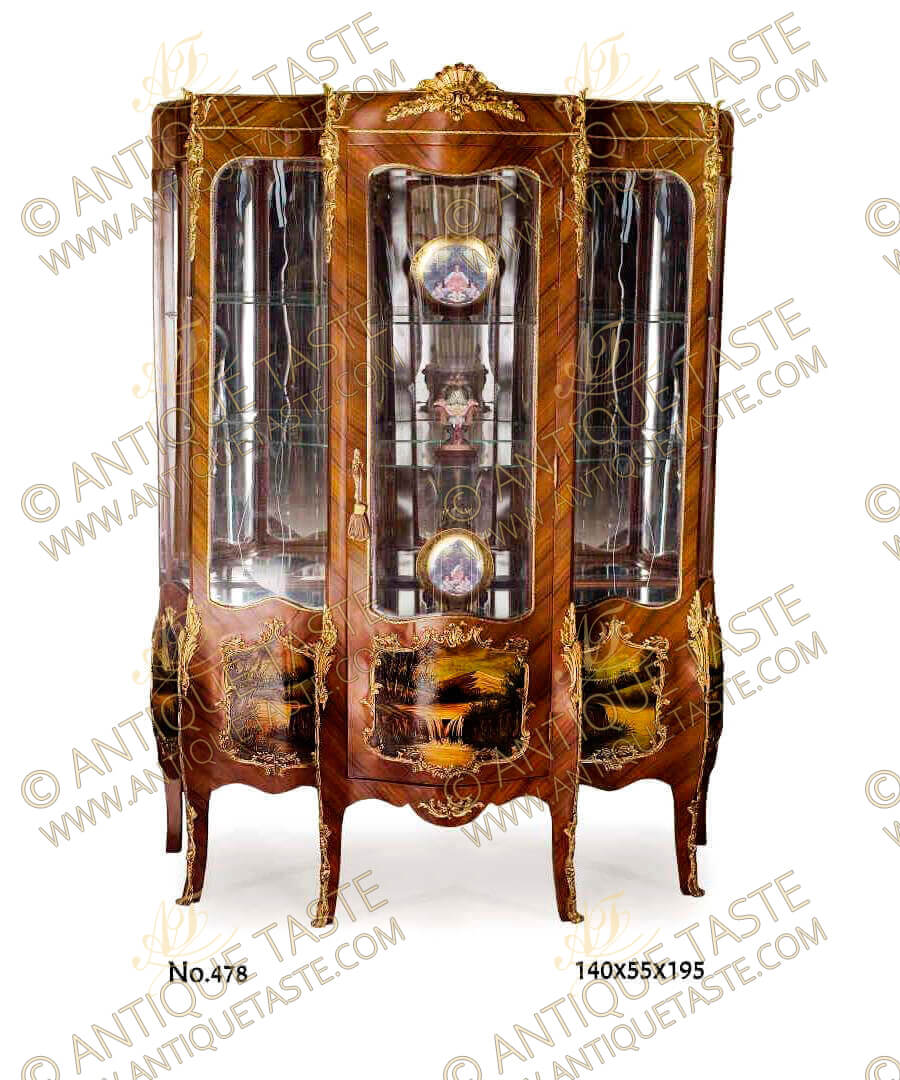Ref#V-478 | Description
A palatial Louis XV and Vernis Martin style ormolu-mounted veneer inlaid Grand Vitrine on the manner of Francois Linke Grande vitrine Louis XV 3 corps bois de violette Panneaux Vernis Martin
The quarter sans traverse veneered shaped top apron crested with an astonishingly chiseled ormolu shell cabochon issuing two wreath branches on the protruding central three-quarter length glazed door.
Exquisitely crafted four ormolu female busts chutes on each top corner surmounted with scrolled acanthus branches and four acanthus ormolu mount chutes on the lower quarter extending on the cabriole slender splayed legs with foliate ormolu filet to the scrolled ormolu sabots. The lower quarter with five Vernis Martin harmonious outdoor panels within scrolled ormolu borders.
Ref#V-478
140-55-195cm
Grande vitrine Louis XV 3 corps bois de violette Panneaux Vernis Martin
There are eight versions of this unusual and distinctive display cabinet in Linke's 'green register' or daybooks. Four are in the original concept as in the present lot with vernis Martin painted panels and four with marquetry panels. Although the design of the present lot could be mistaken for work carried out in Paris in the late 1880s in the style of Roux et Brunet, the concept is exclusively that of the Linke stable. The common theme is explained by Linke's employment of the sculptor Léon Messagé (d.1901) who had earlier designed pieces as an independent artisan for Roux. The most distinctive element being the now almost iconic 'crab-like acanthus' first identified by Christopher Payne in 19th Century European Furniture,Antique's Collector Club, Woodbridge, 1981. Although this model by definition of the early model number alone must have been first thought of in the late 1880s or early 1890s there is no obvious record until the green registers which were compiled in circa 1901 after Linke's success at the Paris 1900 World fair. The first recorded date is1902 for a vernis Martin model painted by Carl Guilbert on 6th January for a fee of 150 French francs, just over twice the cost of the marquetry versions. Despite inflation, Linke only paid Guilbert the same fee for panels on the last version painted in August 1908. However Linke did accept the increase in the cost of the locks, made by his brother Clément Linke from 34 to 54 francs! However the cost price of this version of the cabinet rose from 1,914 francs 75 centimes in 1901 to 2,860 in 1914 the date of the last model made.
François Linke
Francois Linke (1855-1946) was arguably the leading Parisian cabinetmaker of the Belle Epoque the glittering age of fashionable French society, whose influence was felt throughout the world.
Determined to outshine the competition at the Exhibition, Linke had set about creating the most ambitious pieces he could envisage, and more extravagant than had ever been displayed before. The items he exhibited marked a transition from the historicist interpretation of Louis XV and Louis XVI styles, an interpretation that was the mainstay of his nearest rivals, to something startlingly new and vital in its immediacy. Together with Leon Message he developed a new style for the 1900 Exhibition that paid homage to the Louis XV rococo in the fluidity of its approach, but an approach fused with the lively flowing lines of the contemporary and progressive 'art nouveau'.
This risky endeavour was a resounding success, and with his reputation established, La Maison Linke became the pre-eminent furniture house until outset of the Second World War. The technical brilliance of his work and the artistic change that it represented was never to be repeated. His showrooms expanded into prestigious premises in Paris, in the Place Vendome as well as the Faubourg St. Antoine where his workshop had been established. He embarked on many important commissions in the years up to the outbreak of the First World War, making and designing furniture for leading international industrialists and bankers.
After the 1914-1918 World War, Linke undertook the extraordinary commission to furnish the Ras al-Tin Palace in Alexandria for King Fuad of Egypt, possibly the largest single furniture commission ever conceived, eclipsing even Versailles. Linke flourished and remained active until the middle years of the 1930s and died in 1946.
Léon Messagé
Leon Message (1842-1901) was a French sculptor, best known for his sculptural collaboration with Francois Linke for the 1900 Paris Exposition Universelle. Message was also responsible for much of the design and creative work for Roux et Brunet and Joseph-Emmanuel Zwiener.
Message was primarily influenced by rococo ornament but he strove to re-interpret it. He did not produce slavish copies, and his original approach can be appreciated in Linke's celebrated Grande Bibliotheque and Grand Bureau exhibited at the 1900 Paris Exposition Universelle. A number of drawings by Message are recorded and after his success at the exhibition of 1889 he was encouraged to publish his designs.[1] There were five sections to the book, with an elaborate title page surmounted by the sculptor's cipher or talisman of a wing, a pun on his own name as the messenger to the Gods, a motif he used many times on the handles of furniture designed for Linke.
As a sculptor Message was trained to produce a wax maquette or model prior to working on a piece. His maquettes were of the piece of furniture in its entirety, a rare and exacting task occasionally seen for eighteenth century French Royal commissions.
Tags
- #Francois_Linke_vitrine | #Vernis_Martin_Style_Vitrine | #Grande_Vitrine_LouisXV | #Napoleon_Style_China_Cabinet | #French_Napoleon_display_cabinet | #Francois-Linke-display-cabinet | #Luxurious-vitrine | #corner-furniture | #Serre-Bijoux | #jean-henri-riesner-vitrine | #Leon-Message-vitrine | #cabinet-vitrine | #Louis-xv-vitrine | #Louis-xvi-vitrine | #ormolu_mounted_vitrine | #Louis-XIV-vitrine | #display-cabinet | #vernis-martin-style-vitrine | #French-style-vitrine | #glass-vitrine | #English-style-vitrine | #veneer_inlaid_vitrine | #marquetry_vitrine | #Italian-style-vitrine | #glass-round-vitrine | #boulle-style-vitrine | #antique-reproduction-vitrine | #antique-style-display-cabinet | #empire-style-bookcase-vitrine | #display-cabinet-with-porcelain-plaque

